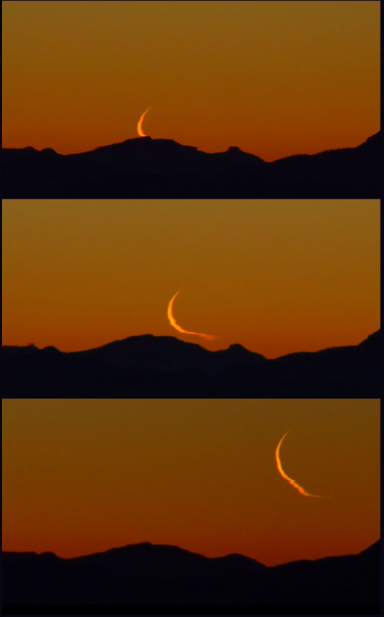OPOD - Lower Tatras Moonrise
OPOD - Lower Tatras Moonrise: Exploring the Bizarre Phenomenon
Have you ever witnessed a moonrise that left you in awe and wonder? Lech Lobodzinski had such an experience at an altitude of 1324m on Lysa Hora Mountain in the Czech Republic. His intention was to observe the captivating morning twilight colors, but he was treated to something even more extraordinary. As he gazed upon the horizon, he captured a truly bizarre moonrise over the Lower Tatras Mountains.
In atmospheric optics, mirages and distortions occur when the rays of a low sun or moon pass through regions of the atmosphere with strong temperature gradients. Temperature alone does not directly affect these phenomena, but it is the vertical temperature gradient that plays a crucial role. This gradient is also a density gradient, which influences the path of light rays passing through it.
Let's delve deeper into the fascinating science behind this peculiar moonrise:
-
Refraction and Density Gradient: When light rays slant downward into a higher density air layer, they are refracted more sharply downward, making the object appear higher. Conversely, rays entering a warmer layer are refracted slightly upwards. This refraction of light creates intriguing visual effects.
-
'Omega' or 'Etruscan Vase' Sun/Moon: When there is a layer of warmer air beneath a cooler layer, it gives rise to an 'omega' or 'Etruscan vase' sun/moon. In this phenomenon, a second image of the sun or moon appears below the "real" one and rises as the real one descends. It creates an illusionary twist in the shape of the celestial body.
-
Temperature Inversion: A temperature inversion occurs when there is a kink in the normal atmospheric temperature variation with increasing height. This inversion produces more complex effects on the appearance of celestial bodies. In the presence of strong temperature gradients, at least three images can be observed - two erect and one inverted.
-
Mountain Winds: The presence of winds blowing across mountains further complicates the atmospheric conditions and introduces additional effects on the appearance of celestial objects. These winds can cause further distortions and mirages, making the phenomenon even more captivating.
As for the specific temperature profile that produced this unique moonrise over the Lower Tatras Mountains, it is challenging to determine with certainty. However, what we can say is that it was a strange and memorable sight that left a lasting impression on Lech Lobodzinski.
The wonders of atmospheric optics continue to amaze us with their intriguing and sometimes perplexing phenomena. Observing the celestial bodies interacting with our atmosphere provides us with a glimpse into the intricate workings of nature. The Lower Tatras Moonrise serves as a reminder of the beauty and complexity that lies within our atmosphere.
Please note that this article has been automatically converted from the old site, and its appearance may not align precisely with the original intent. You can find the original article on atmospheric optics here.

Moonrise over Lower Tatras Mountains
Lech Lobodzinski captured this bizarre moonrise at 1324m altitude on Lysa Hora Mountain in Czech Republic. He had gone there to observe the morning twilight colours. The last thin crescent of the old moon twists and seemingly drifts away in the wind as it climbs over the Lower Tatras Mountains.
©Lech Lobodzinski, shown with permission.

Mirages and distortions are produced when the rays of a low sun or moon pass through atmospheric regions where there are strong temperature gradients. Temperature per se has no direct effect but a vertical temperature gradient is also a density gradient.
Light rays slanting downward into a higher density air layer are refracted more sharply down making the object appear higher. Rays entering a warmer layer are refracted slightly upwards.
A layer of warmer air beneath cooler produces an 'omega' or 'Etruscan vase' sun/moon. A second image is below the �real� sun or moon and rises as the real one descends.
A temperature inversion, a kink in the normal atmospheric temperature variation with increasing height, has more complex effects. When the temperature gradients are strong there are at least three images, two erect and one inverted.
Winds blowing across mountains introduce yet more effects.
What temperature profile produced this moonrise? It is hard to say. But a strange and memorable sight.

Note: this article has been automatically converted from the old site and may not appear as intended. You can find the original article here.
Reference Atmospheric Optics
If you use any of the definitions, information, or data presented on Atmospheric Optics, please copy the link or reference below to properly credit us as the reference source. Thank you!
-
<a href="https://atoptics.co.uk/blog/opod-lower-tatras-moonrise/">OPOD - Lower Tatras Moonrise</a>
-
"OPOD - Lower Tatras Moonrise". Atmospheric Optics. Accessed on November 12, 2024. https://atoptics.co.uk/blog/opod-lower-tatras-moonrise/.
-
"OPOD - Lower Tatras Moonrise". Atmospheric Optics, https://atoptics.co.uk/blog/opod-lower-tatras-moonrise/. Accessed 12 November, 2024
-
OPOD - Lower Tatras Moonrise. Atmospheric Optics. Retrieved from https://atoptics.co.uk/blog/opod-lower-tatras-moonrise/.